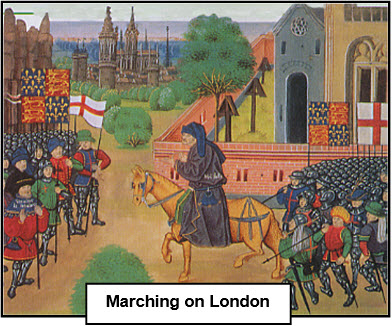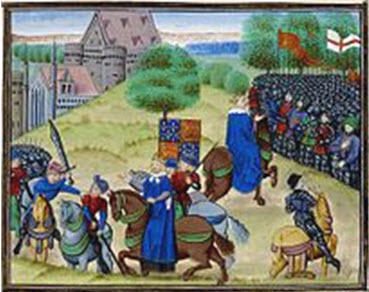


THE PEASANTS’ REVOLT 1381 (R2)
Including:
Wat Tyler
and
John Ball

xxxxxThe Peasants’ Revolt, the first great popular rebellion in English history, was, in fact, a series of riots by agricultural workers all over England, but it was centred in Essex and Kent. Its immediate cause was a three-
xxxxxThe Peasant’s Revolt can certainly be regarded as the first great popular rebellion in English history. It was a series of riots amongst agricultural workers which broke out all over England, but which took a particularly violent form in the counties of Essex and Kent. Its immediate cause was the imposition of a revised poll tax, a flat levy imposed on all over the age of 15 except the clergy. This new tax, coming into force in 1380, increased the previous charge some threefold, and aroused enormous bitterness, falling equally, as it did, on the rich and the poor. The tax collectors who toured the country collecting the tax were hated and feared. In May of that year villagers at Brentwood in Essex drove off one such collector, and this appears to have been the spark that set off the powder keg. Very soon towns and villages throughout the country, but notably in Kent and the south-
 xxxxxBut there were deeper, underlying causes for this unrest, resulting in the main from the economic and social disorder brought about by the ravages of the Black Death. The plague led to a serious shortage of agricultural workers and this accelerated the decline of the feudal system and led to demands for wages as opposed to serfdom. As we have seen, the Statute of Labourers of 1351 attempted to pin wages down to the pre-
xxxxxBut there were deeper, underlying causes for this unrest, resulting in the main from the economic and social disorder brought about by the ravages of the Black Death. The plague led to a serious shortage of agricultural workers and this accelerated the decline of the feudal system and led to demands for wages as opposed to serfdom. As we have seen, the Statute of Labourers of 1351 attempted to pin wages down to the pre-
xxxxxThe French chronicler Jean Froissart (c1337-
 xxxxxAt this stage a second meeting was arranged with the king, this time at Smithfield. Here, the king was accompanied by a number of nobles, their arms hidden beneath their cloaks. Wat Tyler was permitted to address the meeting but when, on being provoked, he drew his dagger, he was immediately attacked by one of the king’s men and badly wounded (illustrated). (He was later dragged from the nearby hospital and beheaded). Again, only the courage and presence of mind of the young king, plus the concessions he then granted, saved the day. The peasants, deprived of their leader and given the promise of reform, including the abolition of forced labour, slowly dispersed. Many were later hunted down and killed, including John Ball, and the concessions made by the king were immediately revoked. The rebels in East Anglia -
xxxxxAt this stage a second meeting was arranged with the king, this time at Smithfield. Here, the king was accompanied by a number of nobles, their arms hidden beneath their cloaks. Wat Tyler was permitted to address the meeting but when, on being provoked, he drew his dagger, he was immediately attacked by one of the king’s men and badly wounded (illustrated). (He was later dragged from the nearby hospital and beheaded). Again, only the courage and presence of mind of the young king, plus the concessions he then granted, saved the day. The peasants, deprived of their leader and given the promise of reform, including the abolition of forced labour, slowly dispersed. Many were later hunted down and killed, including John Ball, and the concessions made by the king were immediately revoked. The rebels in East Anglia -
xxxxxBecause there was an anti-

xxxxxThat the rebels managed to storm and enter the Tower of London clearly indicates that some of the warders supported the revolt and opened the gates. The heads of the four executed by the mob on Tower Hill were displayed on London Bridge. That of Simon of Sudbury, however, was eventually taken to the Parish Church of Sudbury in Suffolk, where it is kept in a safe, and can be seen to this day. The skull clearly supports the account that it took several blows to behead the archbishop. In 2011 it was CT scanned and a facial reconstruction produced, here illustrated.
xxxxxIncidentally, Wat Tyler is the hero of a poem by the English poet Robert Southey, composed in 1794. The other major leader of the rebellion, the priest John Ball, who, after the revolt, was tried and hanged in the presence of the king, was the subject of a romance called The Dream of John Ball, completed in 1887 by the English writer and poet William Morris.
Acknowledgements
Marching on London: 15th century manuscript from the Froissart Chronicles, artist unknown – British Library, London. Death of Wat Tyler: 15th century manuscript from the Froissart Chronicles, artist unknown – British Library, London.
R2-


